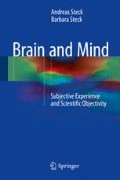Abstract
While physical pain from noxious stimuli is understood in a rather well-defined and limited framework, an all-inclusive concept of how these physical events are translated into the feeling of pain is not yet within reach: this quest directly points to the fundaments of the mind/body relationship. With increasing “encephalization” of the pain system, neuronal mechanisms evolved to allow transition from pain being a purely physical phenomenon to the experience of psychic pain. Prefrontal cortical areas as well as subcortical areas such as the amygdala and cingulate gyrus contribute to the conscious awareness and affective and cognitive evaluation of pain and form part of the multimodal areas of the pain-processing network. The affective and sensory components of pain are closely related: psychological pain activates the same neuronal pathways as those involved in physical pain.
The brain has been said to actively “carve” the properties of pain as it evolves from an acute to a chronic condition. The dynamic changes involved in chronic pain occur at the molecular, synaptic, cellular, and network levels, leading to changes in body perception. How chronic pain affects reward-seeking behavior is a subject of considerable interest for understanding the relationship between pain, mood, and behavior.
Access this chapter
Tax calculation will be finalised at checkout
Purchases are for personal use only
Notes
- 1.
“When I lost my daughter 12 years ago in a horrendous traffic accident, among her papers I found a poem that is now carved on her tombstone. The last stanza is particularly pertinent to the question of whether love can reduce the emotional pain of loss” (Panksepp 2003, ref. 21). “When your days are full of pain, And you don’t know what to do, Recall these words I tell you now—I will always care for you.”
- 2.
Joyful and sorrowful; thoughtful; longing and anxious; in constant anguish; sky-high rejoicing despairing to death; happy alone is the soul that loves (Goethe 1898).
References
Baliki MN, Petre B, Torbey S, Herrmann KM, Huang L, Schnitzer TJ et al (2012) Corticostriatal functional connectivity predicts transition to chronic back pain. Nat Neurosci 15(8):1117–9. doi:10.1038/nn.3153
Bernhardt BC, Singer T (2012) The neural basis of empathy. Annu Rev Neurosci 35:1–23. doi:10.1146/annurev-neuro-062111-150536, Review
Boecker H, Sprenger T, Spilker ME, Henriksen G, Koppenhoefer M, Wagner KJ (2008) The runner’s high: opioidergic mechanisms in the human brain. Cereb Cortex 18(11):2523–31. doi:10.1093/cercor/bhn013
Coenen VA, Panksepp J, Hurwitz TA, Urbach H, Mädler B (2012) Human medial forebrain bundle (MFB) and anterior thalamic radiation (ATR): imaging of two major subcortical pathways and the dynamic balance of opposite affects in understanding depression. J Neuropsychiatry Clin Neurosci 24(2):223–36. doi:10.1176/appi.neuropsych.11080180
Cox JJ, Reimann F, Nicholas AK, Thornton G, Roberts E, Springell K et al (2006) An SCN9A channelopathy causes congenital inability to experience pain. Nature 444(7121):894–8
Damasio AR, Grabowski TJ, Bechara A, Damasio H, Ponto LL, Parvizi J et al (2000) Subcortical and cortical brain activity during the feeling of self-generated emotions. Nat Neurosci 3(10):1049–56
Darwin CR. The expression of the emotions in man and animals, 1st edn. London: John Murray; 1872
Eisenberger NI, Lieberman MD, Williams KD (2003) Does rejection hurt? An FMRI study of social exclusion. Science 302(5643):290–2
Faber CG, Lauria G, Merkies IS, Cheng X, Han C, Ahn HS et al (2012) Gain-of-function Nav1.8 mutations in painful neuropathy. Proc Natl Acad Sci U S A 109(47):19444–9. doi:10.1073/pnas.1216080109
Farmer MA, Baliki MN, Apkarian AV (2012) A dynamic network perspective of chronic pain. Neurosci Lett 520(2):197–203. doi:10.1016/j.neulet.2012.05.001
Flor H (2012) New developments in the understanding and management of persistent pain. Curr Opin Psychiatry 25(2):109–13. doi:10.1097/YCO.0b013e3283503510
Goethe JW (1898) 1749–1832 from Egmont. Act III, Clärchen’s song
Hamzei F, Liepert J, Dettmers C, Adler T, Kiebel S, Rijntjes M et al (2001) Structural and functional cortical abnormalities after upper limb amputation during childhood. Neuroreport 12(5):957–62
Kuner R (2010) Central mechanisms of pathological pain. Nat Med 16(11):1258–66. doi:10.1038/nm.2231
Mitchell SW (1871) Phantom limbs. Lippincott’s Magazine Popular Literature and Science 8:563–9
Neiman S (2009) Moral clarity: a guide for grown-up idealists. Random House, New York
Neugebauer V, Galhardo V, Maione S, Mackey SC (2009) Forebrain pain mechanisms. Brain Res Rev 60(1):226–42. doi:10.1016/j.brainresrev.2008.12.014
Panksepp J (2003) Neuroscience. Feeling the pain of social loss. Science 302(5643):237–9
Pontalis JB (1977) Entre le rêve et la douleur. Editions Gallimard, Paris
Price DD (2000) Psychological and neural mechanisms of the affective dimension of pain. Science 288(5472):1769–72, Review
Schwartz N, Temkin P, Jurado S, Lim BK, Heifets BD, Polepalli JS et al (2014) Chronic pain. Decreased motivation during chronic pain requires long-term depression in the nucleus accumbens. Science 345(6196):535–42. doi:10.1126/science.1253994
Tracey I, Mantyh PW (2007) The cerebral signature for pain perception and its modulation. Neuron 55(3):377–91, Review
Tucker DM, Luu P, Derryberry D (2005) Love hurts: the evolution of empathic concern through the encephalization of nociceptive capacity. Dev Psychopathol 17(3):699–713
Woolf CJ (2010) What is this thing called pain? J Clin Invest 120(11):3742–4. doi:10.1172/JCI45178
Author information
Authors and Affiliations
Rights and permissions
Copyright information
© 2016 Springer International Publishing Switzerland
About this chapter
Cite this chapter
Steck, A., Steck, B. (2016). Pain and Mind-Body. In: Brain and Mind. Springer, Cham. https://doi.org/10.1007/978-3-319-21287-6_11
Download citation
DOI: https://doi.org/10.1007/978-3-319-21287-6_11
Publisher Name: Springer, Cham
Print ISBN: 978-3-319-21286-9
Online ISBN: 978-3-319-21287-6
eBook Packages: MedicineMedicine (R0)

